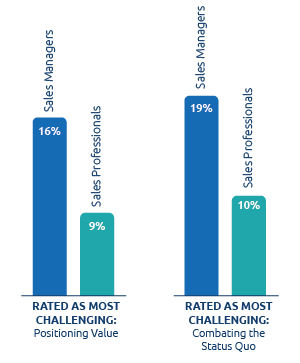Recent research from Richardson and Sales Performance International highlights the importance of following a process that supports your customers from “behind the scenes.”
A strong process drives internal alignment and ensures consistency in customer conversations. It also facilitates communication across the sales organization, which mobilizes the entire team to build momentum toward the close of the sale. Being able to walk in lockstep across your organization is more important than ever — changes in buying behavior mean sellers are tasked with the challenge of managing a growing number of stakeholders through an increasingly complex decision-making process.
As a sales leader, it’s critical to orient your entire sales organization around helping your sellers stay organized to effectively engage your prospects and customers. Here, we look at several key takeaways from this year’s study and explore ways sales organizations can adjust their processes to drive success.
Sales Managers and Their Team Need to Use the Same Playbook
 Data shows a misalignment between sales professionals and managers. This divide can be seen when examining what the two groups cite as the most pressing challenges.
Data shows a misalignment between sales professionals and managers. This divide can be seen when examining what the two groups cite as the most pressing challenges.
One of the top challenges for managers is “positioning value to customers in a persuasive manner.” In contrast, sales professionals indicate that “combating the status quo when trying to close a deal” is one of their most intense challenges.
This finding suggests that the two groups perceive the same problem differently, but there is a common understanding that customers are reluctant to buy.
Sales coaching is a great way to resolve this misalignment and collaboratively build a compelling value statement that helps the sales professional overcome the status quo.
Effective sales leaders engage their sales professionals in coaching conversations that challenge them to reevaluate and refine their value statement throughout the buying journey. Rather than tell the salesperson what to do, a coach must focus helping the rep build habits that will help them deliver the customer’s definition of value.
CRM Systems Need to Support the Process, Not Be the Process
Respondents who believe their CRM system is a valuable tool still struggle with responsibilities that reside on either end of the sales process — namely, gaining appointments and expanding relationships.
 This finding indicates that CRM systems offer value to sales professionals who are already engaged with customers. However, they offer less value for sales professionals who are attempting to make contact with a prospect or grow an existing account. This underscores the importance of creating a process that relies on CRM as a component of the approach and not the approach itself. The challenge becomes one of tying CRM capabilities to desired behaviors and actions.
This finding indicates that CRM systems offer value to sales professionals who are already engaged with customers. However, they offer less value for sales professionals who are attempting to make contact with a prospect or grow an existing account. This underscores the importance of creating a process that relies on CRM as a component of the approach and not the approach itself. The challenge becomes one of tying CRM capabilities to desired behaviors and actions.
Sales organizations need to create a repeatable account planning process that has clearly defined and documented steps — which can be added to the CRM — designed to gain insight into the customer’s key business drivers that will empower them to pursue an account with intentionality.
A Process-Driven Selling Approach Overcomes Status Quo
Eighty-six percent of survey respondents have a formal sales process. A closer look at the data reveals the importance of not only having a formalized process, but also following it.

Consider that 38% of those who attained their 2019 quota “always” follow their organization’s process. Of those who missed their quota, only 16% “always” follow their sales process.
Why are the majority of respondents not always following their processes? One possible answer stands out: sales professionals and leaders struggle to translate strategy into executable processes.
Many see this challenge as monolithic because they believe it demands constructing an entirely new process from the ground up. In truth, many can find success by leveraging existing resources in a different way. They can provide guidance alongside content so that sellers have everything they need to have successful buyer conversations. They can apply new measurement routines to existing data sets. Finally, they can shape the entire culture around sustainment by aligning skills to intended outcomes. These are just a few ways teams can get started on turning strategy into action.
Bringing It All Together
Richardson and Sales Performance International’s annual Selling Challenges Study offers a panoramic view of the issues sales professionals face today with the goal to understand what sales strategies and skills are most relevant in today’s market and how to apply them. The survey respondents represent a diverse group of industries, and their answers reflect the shared concerns of those facing a challenging sales environment.
With a clear picture of the sales challenges that are most relevant in today’s market, sales leaders can forge ahead in establishing and following processes that support customers.




